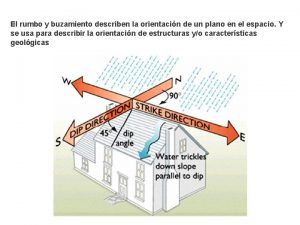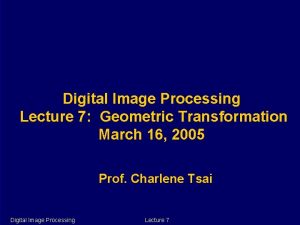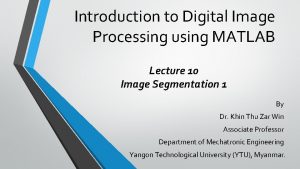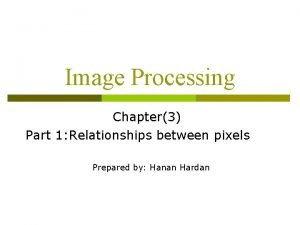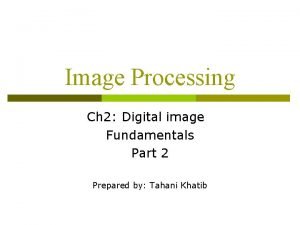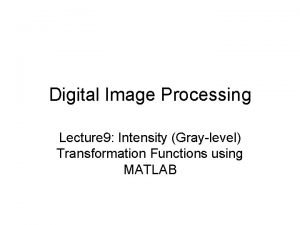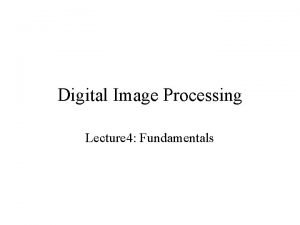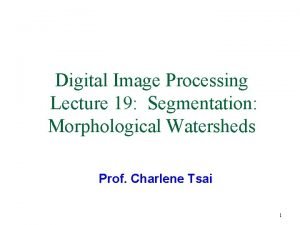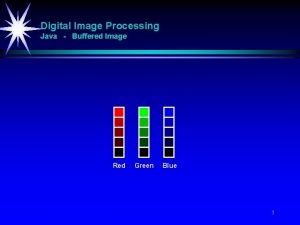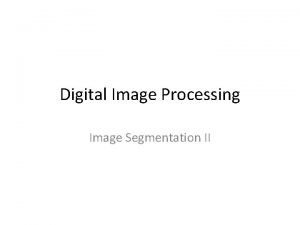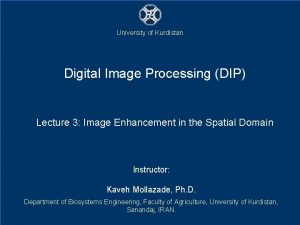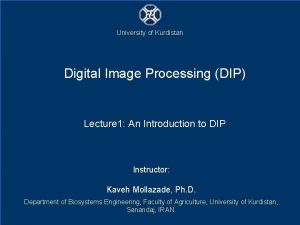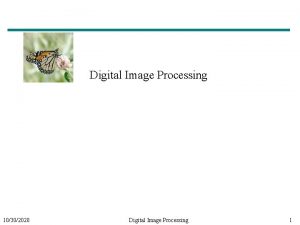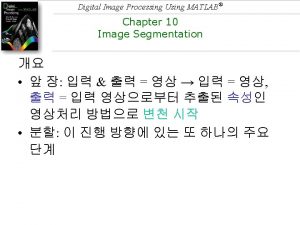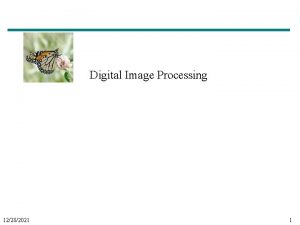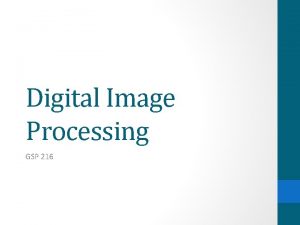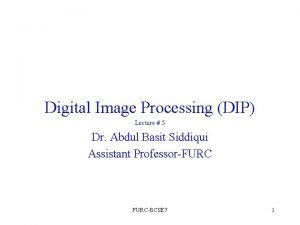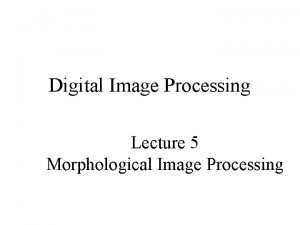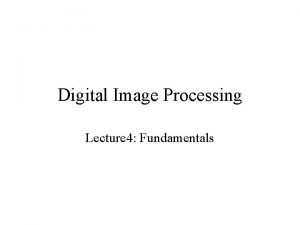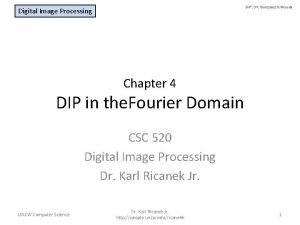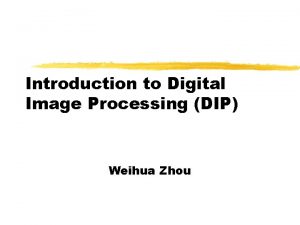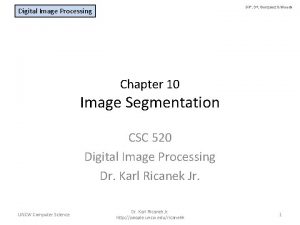University of Kurdistan Digital Image Processing DIP Lecture


































- Slides: 34

University of Kurdistan Digital Image Processing (DIP) Lecture 2: Digital Image Fundamentals Instructor: Kaveh Mollazade, Ph. D. Department of Biosystems Engineering, Faculty of Agriculture, University of Kurdistan, Sanandaj, IRAN.

Contents This lecture will cover: – The human visual system – Light and the electromagnetic spectrum – Image representation – Image sensing and acquisition – Sampling, quantization, and resolution Digital Image Processing – Department of Biosystems Engineering – University of Kurdistan http: //agri. uok. ac. ir/kmollazade 1

Human visual system - The best vision model we have! - Knowledge of how images form in the eye can help us with processing digital images. - We will take just a whirlwind tour of the human visual system. Digital Image Processing – Department of Biosystems Engineering – University of Kurdistan http: //agri. uok. ac. ir/kmollazade 2

Structure of the human eye - The lens focuses light from objects onto the retina. - The retina is covered with light receptors called cones (6 -7 million) and rods (75 -150 million). - Cones are concentrated around the fovea and are very sensitive to colour. - Rods are more spread out and are sensitive to low levels of illumination. Digital Image Processing – Department of Biosystems Engineering – University of Kurdistan http: //agri. uok. ac. ir/kmollazade 3

Structure of the human eye (cont …) Digital Image Processing – Department of Biosystems Engineering – University of Kurdistan http: //agri. uok. ac. ir/kmollazade 4

Structure of the human eye (cont …) Cones and rods distribution Digital Image Processing – Department of Biosystems Engineering – University of Kurdistan http: //agri. uok. ac. ir/kmollazade 5

Structure of the human eye (cont …) Digital Image Processing – Department of Biosystems Engineering – University of Kurdistan http: //agri. uok. ac. ir/kmollazade 6

Blind-spot experiment Draw an image similar to that below on a piece of paper (the dot and cross are about 6 inches apart). Close your right eye and focus on the cross with your left eye. Hold the image about 20 inches away from your face and move it slowly towards you. The dot should disappear! Digital Image Processing – Department of Biosystems Engineering – University of Kurdistan http: //agri. uok. ac. ir/kmollazade 7

Image formation in the eye - Muscles within the eye can be used to change the shape of the lens allowing us focus on objects that are near or far away. - An image is focused onto the retina causing rods and cones to become excited which ultimately send signals to the brain. 15/100=h/17 or h=2. 55 mm Digital Image Processing – Department of Biosystems Engineering – University of Kurdistan http: //agri. uok. ac. ir/kmollazade 8

Brightness adaptation and discrimination - The human visual system can perceive approximately 1010 different light intensity levels. - However, at any one time we can only discriminate between a much smaller number – brightness adaptation - Similarly, the perceived intensity of a region is related to the light intensities of the regions surrounding it. An example of Mach bands Digital Image Processing – Department of Biosystems Engineering – University of Kurdistan http: //agri. uok. ac. ir/kmollazade 9

Brightness adaptation and discrimination (cont …) Digital Image Processing – Department of Biosystems Engineering – University of Kurdistan http: //agri. uok. ac. ir/kmollazade 10

Brightness adaptation and discrimination (cont …) An example of simultaneous contrast Digital Image Processing – Department of Biosystems Engineering – University of Kurdistan http: //agri. uok. ac. ir/kmollazade 11

Brightness adaptation and discrimination (cont …) Digital Image Processing – Department of Biosystems Engineering – University of Kurdistan http: //agri. uok. ac. ir/kmollazade 12

Optical illusions Our visual systems play lots of interesting tricks on us. Digital Image Processing – Department of Biosystems Engineering – University of Kurdistan http: //agri. uok. ac. ir/kmollazade 13

Light and the electromagnetic spectrum - Light is just a particular part of the electromagnetic spectrum that can be sensed by the human eye. - The electromagnetic spectrum is split up according to the wavelengths of different forms of energy. Digital Image Processing – Department of Biosystems Engineering – University of Kurdistan http: //agri. uok. ac. ir/kmollazade 14

Reflected light - The colours that we perceive are determined by the nature of the light reflected from an object. Whi te L - For example, if white light is shone onto a green object most wavelengths ight Colours Absorbed Green Light are absorbed, while green light is reflected from the object. Digital Image Processing – Department of Biosystems Engineering – University of Kurdistan http: //agri. uok. ac. ir/kmollazade 15

Sampling, quantization, and resolution In the following slides we will consider what is involved in capturing a digital image of a real-world scene – Image sensing and representation – Sampling and quantization – Resolution Digital Image Processing – Department of Biosystems Engineering – University of Kurdistan http: //agri. uok. ac. ir/kmollazade 16

Image representation - Before we discuss image acquisition recall that a digital image is composed of M rows and N columns of pixels each storing a value. col - Pixel values are most often grey levels in the range 0 -255 (black-white). - We will see later on that images can easily be represented as matrices. f (row, col) row Digital Image Processing – Department of Biosystems Engineering – University of Kurdistan http: //agri. uok. ac. ir/kmollazade 17

Image acquisition Images are typically generated by illuminating a scene and absorbing the energy reflected by the objects in that scene. – Typical notions of illumination and scene can be way off: • X-rays of a skeleton • Ultrasound of an unborn baby • Electro-microscopic images of molecules Digital Image Processing – Department of Biosystems Engineering – University of Kurdistan http: //agri. uok. ac. ir/kmollazade 18

Image sensing - Incoming energy lands on a sensor material responsive to that type of energy and this generates a voltage. - Collections of sensors are arranged to capture images. Imaging sensor Line of image sensors Array of image sensors Digital Image Processing – Department of Biosystems Engineering – University of Kurdistan http: //agri. uok. ac. ir/kmollazade 19

Image sensing (cont …) Using a single sensor Using sensor strips and rings Digital Image Processing – Department of Biosystems Engineering – University of Kurdistan http: //agri. uok. ac. ir/kmollazade 20

Image sampling and quantization - A digital sensor can only measure a limited number of samples at a discrete set of energy levels. - Quantisation is the process of converting a continuous analogue signal into a digital representation of this signal. Digital Image Processing – Department of Biosystems Engineering – University of Kurdistan http: //agri. uok. ac. ir/kmollazade 21

Image sampling and quantization (cont …) Remember that a digital image is always only an approximation of a real world scene. Digital Image Processing – Department of Biosystems Engineering – University of Kurdistan http: //agri. uok. ac. ir/kmollazade 22

Digital image representation Digital Image Processing – Department of Biosystems Engineering – University of Kurdistan http: //agri. uok. ac. ir/kmollazade 23

Spatial resolution - The spatial resolution of an image is determined by how sampling was carried out. - Spatial resolution simply refers to the smallest discernable detail in an image. – Vision specialists will often talk about pixel size. – Graphic designers will talk about dots per inch (DPI). 5. 1 ls xe i p a Meg Digital Image Processing – Department of Biosystems Engineering – University of Kurdistan http: //agri. uok. ac. ir/kmollazade 24

Spatial resolution (cont …) Digital Image Processing – Department of Biosystems Engineering – University of Kurdistan http: //agri. uok. ac. ir/kmollazade 25

Spatial resolution (cont …) 1024 512 256 128 64 32 Digital Image Processing – Department of Biosystems Engineering – University of Kurdistan http: //agri. uok. ac. ir/kmollazade 26

Intensity level resolution refers to the number of intensity levels used to represent the image. – The more intensity levels used, the finer the level of detail discernable in an image. – Intensity level resolution is usually given in terms of the number of bits used to store each intensity level. Number of Bits Number of Intensity Levels Examples 1 2 0, 1 2 4 00, 01, 10, 11 4 16 0000, 0101, 1111 8 256 0011, 0101 16 65, 536 10101010 Digital Image Processing – Department of Biosystems Engineering – University of Kurdistan http: //agri. uok. ac. ir/kmollazade 27

Intensity level resolution (cont …) 256 grey levels (8 bits per pixel) 16 grey levels (4 bpp) 128 grey levels (7 bpp) 64 grey levels (6 bpp) 32 grey levels (5 bpp) 8 grey levels (3 bpp) 4 grey levels (2 bpp) 2 grey levels (1 bpp) Digital Image Processing – Department of Biosystems Engineering – University of Kurdistan http: //agri. uok. ac. ir/kmollazade 28

Saturation & noise Digital Image Processing – Department of Biosystems Engineering – University of Kurdistan http: //agri. uok. ac. ir/kmollazade 29

Resolution: How much is enough? The big question with resolution is always how much is enough? – This all depends on what is in the image and what you would like to do with it. – Key questions include: • Does the image look aesthetically pleasing? • Can you see what you need to see within the image? Digital Image Processing – Department of Biosystems Engineering – University of Kurdistan http: //agri. uok. ac. ir/kmollazade 30

Resolution: How much is enough? (cont …) The picture on the right is fine for counting the number of cars, but not for reading the plate number. Digital Image Processing – Department of Biosystems Engineering – University of Kurdistan http: //agri. uok. ac. ir/kmollazade 31

Summary We have looked at: – Human visual system – Light and the electromagnetic spectrum – Image representation – Image sensing and acquisition – Sampling, quantization, and resolution Next time we start to look at techniques for image enhancement. Digital Image Processing – Department of Biosystems Engineering – University of Kurdistan http: //agri. uok. ac. ir/kmollazade 32

Digital Image Processing – Department of Biosystems Engineering – University of Kurdistan http: //agri. uok. ac. ir/kmollazade
 Trend plunge dip dip direction
Trend plunge dip dip direction Trend plunge dip dip direction
Trend plunge dip dip direction Histogram processing in digital image processing
Histogram processing in digital image processing Neighborhood processing in image processing
Neighborhood processing in image processing A generalization of unsharp masking is
A generalization of unsharp masking is Point processing in image processing
Point processing in image processing Image enhancement point processing techniques
Image enhancement point processing techniques Thinning and thickening in image processing example
Thinning and thickening in image processing example Translate
Translate Optimum notch filter in image processing
Optimum notch filter in image processing Image compression in digital image processing
Image compression in digital image processing Image segmentation in digital image processing
Image segmentation in digital image processing Objective fidelity criteria
Objective fidelity criteria Image sharpening and restoration
Image sharpening and restoration Geometric transformation in digital image processing
Geometric transformation in digital image processing Zooming and shrinking in digital image processing
Zooming and shrinking in digital image processing Image transform in digital image processing
Image transform in digital image processing Imtransform matlab
Imtransform matlab Noise
Noise Image processing lecture notes
Image processing lecture notes Geometric transformation in digital image processing
Geometric transformation in digital image processing Topological descriptors in image processing
Topological descriptors in image processing Representation and description in digital image processing
Representation and description in digital image processing Threshold image matlab
Threshold image matlab Segmentation in digital image processing
Segmentation in digital image processing Basic relationship between pixels
Basic relationship between pixels Piecewise linear transformation in digital image processing
Piecewise linear transformation in digital image processing Zooming and shrinking of digital images
Zooming and shrinking of digital images Gray level transformation in digital image processing
Gray level transformation in digital image processing In 4 neighbors of a pixel p
In 4 neighbors of a pixel p Coordinate conventions in digital image processing
Coordinate conventions in digital image processing Dam construction in image processing
Dam construction in image processing Digital image processing java
Digital image processing java Thresholding in digital image processing
Thresholding in digital image processing Segmentation in digital image processing
Segmentation in digital image processing

